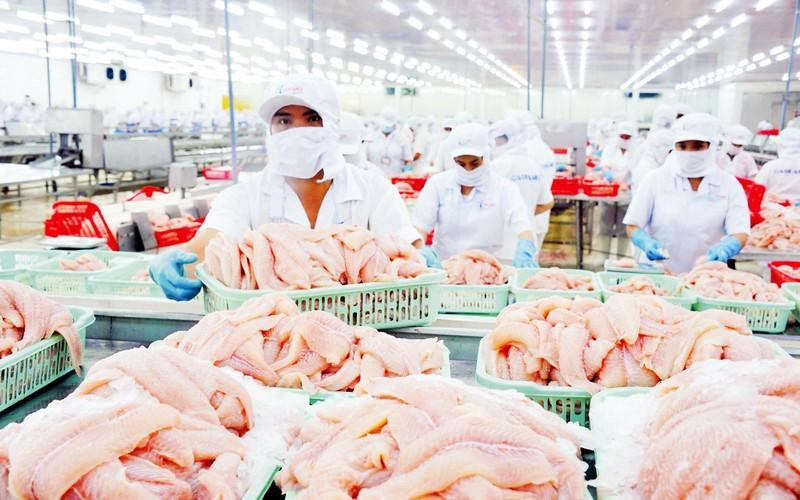Since the beginning of 2022, when the Russia-Ukraine conflict broke out and the “ghost” of global inflation is threatening many economic sectors, this is a good opportunity for the ‘tra’ fish industry to increase its export turnover to the international market, thanks to its reasonable prices and advantages. Most markets have increased their imports of Vietnamese ‘tra’ fish by 40% to 200%.
More than 400 enterprises export ‘tra’ fish
China and the US are currently the two largest consumption markets of Vietnamese ‘tra’ fish, accounting for 30% and 23% respectively. In the US, while imports of white fish species such as cod, hake, and pollock, either decreased or only increased slightly, the imports of ‘tra’ fish surged sharply. The average import price of frozen ‘tra’ fish fillets to the US market reached 4.26 USD per kg, up 53% compared to the average import price in 2021.
Meanwhile, ‘tra’ fish exports to the Chinese market continued to recover strongly, with a ten-month export turnover of 647 million USD, up 110% compared to the same period last year. The average import price of frozen ‘tra’ fish fillets to the Chinese market reached 2.45 USD per kg in 2022, 64% higher than the price last year.
In addition, Vietnam has also promoted exports to the markets of member countries of the Comprehensive and Progressive Agreement for Trans-Pacific Partnership (CPTPP) and some Asian markets, to take advantage of tariffs and other geographical factors. ‘tra’ fish exports to Canada saw a sharp increase in the first 10 months of this year, more than 4 times higher over the same period last year, reaching 40 million USD and accounting for 2.5% of total ‘tra’ fish export turnover. ‘tra’ fish exports to Australia, Singapore, Malaysia and Chile all saw triple-digit growth during the 10 months, with an increase of 108% to 166% over the same period in 2021.
Vietnam currently has more than 400 enterprises participating in exporting ‘tra’ fish. Most ‘tra’ fish businesses saw a growth in sales compared to the same period last year, mainly thanks to higher export prices. With the results achieved in the first 10 months of this year, the total export revenue of ‘tra’ fish is expected to reach more than 2.5 billion USD for the entirety of 2022, an increase of 58% compared to 2021.
Looking towards export turnover of 2.5 billion USD
According to the General Director of Vinh Hoan Joint Stock Company Nguyen Ngo Vi Tam, Vietnam was heavily affected by the COVID-19 pandemic in 2021, causing interruptions to ‘tra’ fish processing activities, while Vietnam is the largest ‘tra’ fish exporter in the world. This left importers with a shortage of inventories. Therefore, the demand for imported ‘tra’ fish has increased in most markets in 2022, promoting export growth.
The cost of ‘tra’ fish raw materials and transportation is at a high level, but the price increase of ‘tra’ fish products is not significant, compared to other types of aquatic products. In the context of record inflation, ‘tra’ fish has become a suitable choice for many consumers thanks to its affordable prices. Vietnamese ‘tra’ fish processing and exporting enterprises also actively share a part of transportation costs with partners and importers, to maintain reasonable prices and make good use of market demand, to maintain long-term growth momentum.
The Vietnamese ‘tra’ fish industry also has significant advantages in a large market like China. Communications Director of the Vietnam Association of Seafood Exporters and Producers (VASEP) Le Hang said that China’s Zero COVID policy has affected the country’s manufacturing industries, including the seafood industry. Fishing and aquaculture have been reduced partly because of China’s COVID-19 control regulations. Therefore, China has to increase imports from other countries, to make up for the shortfall in domestic consumption and processing as well. China will continue to be the main and potential market for Vietnamese ‘tra’ fish products this year and the next year.
To achieve the goal of exporting more than 2.5 billion USD in 2022, more synchronous solutions both in the immediate and long term should be implemented. According to Deputy Minister of Agriculture and Rural Development Phung Duc Tien, the value chain of Vietnamese ‘tra’ fish needs to take advantage of local raw materials, implement production in the direction of a circular economy and continue to expand the export market. In particular, it is necessary to take advantage of free trade agreements to boost exports, promote brands, and increase deep processing to achieve export goals.
















